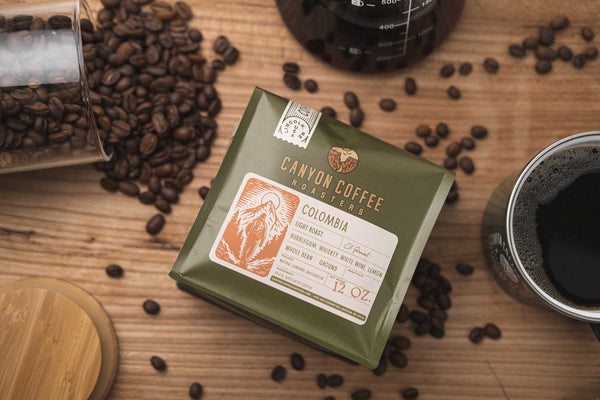
5 Tips for Running Successful Coffee Businesses
Introduction
Coffee businesses can be incredibly profitable. There’s a reason why coffee shops are popping up on corners across America. Yet, a significant portion of independent coffee shops will be closed within 5 years of opening. What takes a coffee business from being a victim of this statistic to profitability and sustainable growth? Canyon Coffee Roasters has been working with independent coffee shops for 20 years and has uncovered 5 tips for running successful coffee businesses.
Turn Away From Free Refills
Respect yourself and the product you create.
Free refills are the profit killer. Coffee can be an incredibly profitable product if shops are intentional about selling it instead of giving it away. So many excellent coffee businesses struggle to turn profit on their beans by not managing the refill strategy of their shop. There are two common situations that lead down this slippery slope. First, the coffee is self-service. Regardless of the refill strategy of the coffee shop, having self-service coffee leads customers to believe that refills are free. Moreover, it encourages customers to refill their cup. It shouldn’t come as a surprise that one simple free refill cuts revenue in half. What if that customer has three or four refills? You get the picture. Second, the coffee is behind the bar, but refills are offered for free or are not managed. While not encouraging refills as much as self-service, each free refill given out slashes revenue.
We’ve spent some time researching different refill strategies and their effects on profit. While far from perfect math, these general numbers illustrate the point well. Factoring in light employee consumption of drip coffee, a coffee shop can generate greater than 220% gross profit on coffee with zero free refills. If a single free refill is given to 50% of customers, that number reduces to 83% gross profit. That’s a dramatic change in margin for a single free refill to only 50% of purchasing customers, not to mention the labor, overhead, and other expenses that come along with running a coffee business. If a mere $0.25 is charged to those 50% of customers per refill, gross profit increases to over 100%. But what if greater than 50% of customers request a refill? What if customers take 2 or 3 refills each? What starts as a profit can easily turn to a loss.
Know Your Numbers
Have an awareness of the health of your business; make decisions to improve it.
While not exclusive to coffee businesses, it’s essential for businesses to know their numbers inside and out. It’s important to continually revisit those numbers to ensure they’re accurate. In today’s turbulent economic environment, it’s common for costs to increase unexpectedly and/or significantly. If business owners are not diligent about regularly checking costs against prices, they could easily be selling their product at a loss without their knowledge. Create a spreadsheet to track per-unit cost. Each time a cost increases, make the change in the spreadsheet. Audit your numbers as frequently as reasonable. Have a basic understanding of revenue, cost of good sold, expenses, and profit. Create difficult, yet achievable goals to work towards. Small and large business owners alike wear many hats. It’s not always easy to get it all done. Place an emphasis on knowing your numbers, it’s the most important element to sustainable success.
Choose Multifunctional Products
Pick ingredients that won’t turn into waste.
New product development and product selection are important parts of running a coffee business. Staying current on customer trends will enable your business to maintain relevance in a rapidly changing environment. Yet new product offerings can easily turn into waste or a bloated inventory collecting dust on a back room shelf. While it’s tempting to try out a new drink with a unique set of ingredients, it’s essential to ask yourself a few simple questions before making those purchases.
- Will this new product sell?
- What is the shelf life on the new ingredients?
- Can I use the new ingredients to make other offerings? Can they be cross applied?
- What ingredients do I already have that would easily substitute for the new ingredients?
First, consider whether your customers will purchase the new product regularly. If your customers purchase drip coffee on the way to the office, perhaps think twice about offering a new rose flavored matcha latte. But if you’re confident in the product selling or are looking to attract new customers through new product offerings, consider the ingredients the product is made from. Be sure to know the shelf life on the ingredients. If you find yourself concerned about waste, consider how you can use the new ingredients in other offerings. If the new ingredients are not easily cross-applied, consider your existing ingredients as a substitute. Seasonal products are important to offer but can produce a lot of waste. Aim to use all ingredients in multiple offerings, limiting waste and increasing product turnover.
Develop a Brand Identity
Building genuine, emotional relationships with customers.
Developing a brand identity helps businesses differentiate themselves from competition, build positive brand awareness in their communities, and ultimately attract new regular customers. Consumers often look at coffee products as easily interchangeable, instead turning to brand identity to attract their initial purchases. It is important for coffee businesses to build and maintain a strong brand identity to create a loyal community. Brand identity does not render a quality product unimportant. Instead, it enhances the need for a quality product to retain the new customers that brand identity attracts. In fact, the first step to forming a strong brand identity is to develop a compelling product advantage.
Often the idea of brand identity gets mistaken for only the visual elements of the brand. But the concept extends to all aspects of the business. Other strategies for building a strong brand identity could be getting your product in the hands of prospective customers by offering samples or product trials, emulating or working to improve on businesses larger than yours, engaging with customers online or in-person to build a loyal brand community, developing visual and cohesive brand elements, building associations with other local businesses with established brand identities, and conducting and leveraging low-cost market research like customer surveys.
Create Good Products
Stick with the basics.
While this might seem like a given, it’s anything but. It’s easy to lose sight of the processes that create a quality product while focusing on everything else that makes a business run. At the end of the day, though, product quality and customer service are what keeps customers coming back. The basics are, and always will be, important. Focus in on processes creating positive customer interactions. Make sure product quality and production are always a priority. Invest in learning more about your craft, working to become a master. Add your own unique twist to products or services to create a memorable customer experience. Coffee is a craft with depth. There is always more to learn. Small process changes can lead to monumental product improvement. There is a wealth of material online to digest, but there are also professional classes to take either online or in-person. Vendors often offer trainings that are personalized and one-on-one.
About the Author
Nathan Jones is the owner of Canyon Coffee Roasters in Lincoln, Nebraska. He has extensive experience (10+ years) in the coffee industry, both as a roasting professional and barista. Nate’s love of coffee, people, and community inspire him to share his knowledge with others with the aim of demystifying the rapidly expanding world of specialty coffee and create meaningful relationships along the way. Nate’s favorite way of drinking coffee is either as a latte or from his Moccamaster, shared with his wife Kate. Nate enjoys spending time with his friends and family when he’s not posted up at the roaster.

